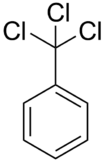Benzotrichloride
| |||
| Names | |||
|---|---|---|---|
| IUPAC name
(Trichloromethyl)benzene | |||
| Other names
Toluene trichloride Phenyl chloroform alpha,alpha,alpha-Trichlorotoluene | |||
| Identifiers | |||
| 98-07-7 | |||
| 3D model (Jmol) | Interactive image | ||
| ChemSpider | 7089 13882366 | ||
| ECHA InfoCard | 100.002.395 | ||
| KEGG | C19166 | ||
| PubChem | 7367 | ||
| RTECS number | XT9275000 | ||
| UNII | U62VHG99AM | ||
| |||
| |||
| Properties | |||
| C7H5Cl3 | |||
| Molar mass | 195.48 | ||
| Appearance | Clear liquid | ||
| Density | 1.3756 g/mL | ||
| Melting point | −5.0 °C (23.0 °F; 268.1 K) | ||
| Boiling point | 220.8 °C (429.4 °F; 493.9 K) | ||
| 0.05g/L | |||
| Solubility | organic solvents | ||
| Hazards | |||
| R-phrases | R45 R22 R23 R37/38 R41 | ||
| S-phrases | S53 S45 | ||
| NFPA 704 | |||
| Flash point | 97.22 °C (207.00 °F; 370.37 K) | ||
| 420 °C (788 °F; 693 K) | |||
| Except where otherwise noted, data are given for materials in their standard state (at 25 °C [77 °F], 100 kPa). | |||
| | |||
| Infobox references | |||
Benzotrichloride, also known as trichlorotoluene is an organic compound with the formula C6H5CCl3. It is principally used as an intermediate in the preparation of other chemical products such as dyes.[1][2][3]
It is classified as an extremely hazardous substance in the United States as defined in Section 302 of the U.S. Emergency Planning and Community Right-to-Know Act (42 U.S.C. 11002), and is subject to strict reporting requirements by facilities which produce, store, or use it in significant quantities.[4]
Preparation
Benzotrichloride is produced by the free radical chlorination of toluene, catalysed by light or radical initiators such as dibenzoyl peroxide. Two intermediates are observed:
Uses
Benzotrichloride is partially hydrolysed to benzoyl chloride:[1]
- C6H5CCl3 + H2O → C6H5C(O)Cl + 2 HCl
It is also transformed into benzotrifluoride, a precursor to pesticides:[5]
- C6H5CCl3 + 3 KF → C6H5CF3 + 3 KCl
References
- 1 2 Rossberg, Manfred; Lendle, Wilhelm; Pfleiderer, Gerhard; Tögel, Adolf; Dreher, Eberhard-Ludwig; Langer, Ernst; Rassaerts, Heinz; Kleinschmidt, Peter; Strack, Heinz; Cook, Richard; Beck, Uwe; Lipper, Karl-August; Torkelson, Theodore R.; Löser, Eckhard; Beutel, Klaus K.; Mann, Trevor (2006). "Chlorinated Hydrocarbons". Ullmann's Encyclopedia of Industrial Chemistry: 139. doi:10.1002/14356007.a06_233.pub2.
- ↑ Merck Index, 11th Edition, 1120.
- ↑ Benzotrichloride Data page at Inchem.org
- ↑ "40 C.F.R.: Appendix A to Part 355—The List of Extremely Hazardous Substances and Their Threshold Planning Quantities" (PDF) (July 1, 2008 ed.). Government Printing Office. Retrieved October 29, 2011.
- ↑ Bonath, B.; Förtsch, B.; Saemann, R. (1966). "Kinetische Untersuchung einer Seitenkettenchlorierung unter Verwendung eines Analogcomputers". Chemie Ingenieur Technik. 38 (7): 739–742. doi:10.1002/cite.330380711.


